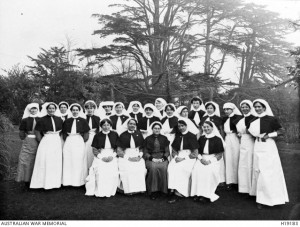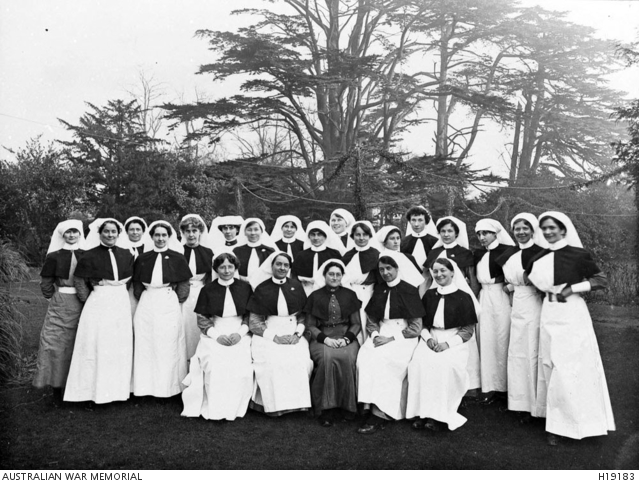
Australian Staff Nurses in the grounds of No 1 Australian Auxiliary Hospital, Harefield, England.
Image courtesy Australian War Memorial.
During the First World War Australian nurses served in 192 locations overseas, in Egypt, Lemnos, England, France, Belgium, Germany, Italy, Greece, Turkey, Salonika, Palestine, Mesopotamia and India, as well as on 39 ships.
It is difficult to determine the exact number of Australian nurses who served since there is no complete official nominal roll of nurses for World War One. According to the Australian War Memorial 2,139 nurses served with the Australian Army Nursing Service, and 130 with the Queen Alexandra Imperial Military Nursing Service. A further 423 nurses served in hospitals in Australia. The National Archives of Australia cites 2,304 confirmed nurses, and perhaps as many as 2,497.
Of those nurses who served overseas for whom there are detailed statistics, seven were under 21 (despite the official minimum age being 25), 1,184 were aged 21–30, 947 were aged 31–40, and 91 were 41 or older. 25 nurses died from injuries or from disease whilst on active service, and 388 were decorated for “bravery in the face of danger.”
The Australian Army Medical Corps (AAMC) established the Australian Army Nursing Service Reserve (AANSR) on 1 July 1902. It was organised from ‘those trained nurses … qualified and willing to serve as such with stationary Field Hospitals and Base Hospitals when required upon a National Emergency.” Nurses were expected to be single or widowed.
When war was declared in August 1914 the Commonwealth called up the nursing Reserve and by October 1914 over 300 nurses had volunteered for the service. Nurses’ motives in volunteering for active service were varied. Some – like soldiers – craved adventure; many felt a patriotism for nation and empire, others sought independence, or to advance their career. Financial gain, however, was not an incentive, since military nurses’ pay was generally less than civilian rates of pay.
In November 1948 the Australian Army Nursing Service Reserve was renamed the Royal Australian Army Nursing Service (RANS), and in July 1949 became part of the regular Army.
New Zealand born military doctor Robert Campbell Begg described nursing during WWI as “the most important job of all”, claiming that on the battlefield hot drinks and warm blankets administered by nurses saved more lives than doctors’ drugs and operative skill. Mortality rates during the war would have been much higher without competent military nursing. Nurses worked relentlessly to reduce the shock suffered by casualties, to prevent dehydration and excessive blood loss, to curtail the onset of infection or pneumonia, all of which could prove fatal. Skilled nursing also helped to alleviate soldier’s depression while increasing their will to live.
Nurses often worked under deplorable conditions. The No 3 Australian General Hospital was established in August 1915 at West Mudros on the island of Lemnos, Greece, in preparation for the evacuation of Gallipoli. Medical staff were forced to sleep outdoors on their first night there, and their equipment did not arrive for a further three weeks. Nurses worked in tents in primitive conditions, sterilising equipment and preparing food by spirit lamp, with scant water and other supplies.
The battle of Messines on 7 June 1917 was the first large-scale action involving Australian troops in Belgium. Nurses at two Australian casualty clearing stations admitted 2,800 wounded men in 48 hours, clearing over 2,500 as well as assisting in over 1,000 operations. They managed to perform their duties whilst being bombed and showered by flying glass.
At the conclusion of the war many nurses struggled to readjust to civilian life. Some could no longer work as nurses; others were unable to work at all. Women were not recognised as military veterans by the government, thus they were denied the much-needed healthcare and financial benefits available to returning soldiers.
Australia’s Army nurses received national recognition in 1999 with the dedication of the Australian Service Nurses’ National Memorial in Canberra. Located in Anzac Parade, the cast glass memorial was unveiled on 2 October 1999 by the Governor-General, Sir William Deane.
The memorial is dedicated to Australian Army Nurses past and present, who have cared for the sick and wounded since the South African War. Designed by sculptor Robin Moorhouse, the memorial is made of etched glass, with text and images cast into the inner walls that portray the history and contribution of Australian Service Nursing.
In the words of the designer, the memorial is “a celebration of nurses’ lives, their courage and compassion”.
To date 29 nurses from Orange and the surrounding area have been identified:
ARTHUR, Mary Ellen Aloysius (Mollie)
ASHDOWN, Maud
BOND, Ena Marion
BOON, Gladys Elizabeth Clare
CARTER, Ursula Mary
CREAL, Rose Ann
DUNSTAN, Edith Lillian
DWYER, Agnes Ellen
GOODMAN, Pearl Stella
HIGMAN, Naomi
KEENAN, Mary
KING, Esther Wynne
KING, Lydia Kate
LEAKE, Nellie
LEE, Violet Claire
LEWIS, Florence Laura
LOWE, Elma Constance Apsley
MACANENE, Rose
McDONALD, Florence Emily Isabel
McLEAN, Christina Elizabeth
McRAE, Elizabeth
MOULDER, Dora
O’NEILL, Emily Gertrude
RYAN, Mollie Josephine
SKIDMORE, Jean Gillies
SKIDMORE, Margaret
SOLLING, Wilhelmina Jane
SPALDING, Florence Ethel
STONE, Constance Adelaide
Australian Army Nursing Service (AANS) 1914-15 outdoor dress
* De Vries, Susanna 2013, Australian heroines of World War One : Gallipoli, Lemnos and the Western Front, Pirgos Press, Chapel Hill, QLD.
* Goodman, Rupert Douglas 1988, Our war nurses: the history of the Royal Australian Army Nursing Corps, 1902-1988, Boolarong Publications, Brisbane, QLD.
* Harris, Kirsty 2011, More than bombs and bandages : Australian Army nurses at work in World War I, Big Sky Publishing, Newport, NSW.
* Rees, Peter 2008, The other ANZACS: nurses at war 1914-1918, Allen & Unwin, Crows Nest, NSW

